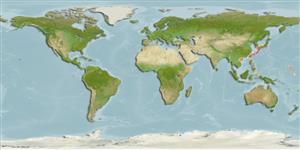>
Ovalentaria/misc (Various families in series Ovalentaria) >
Pomacentridae (Damselfishes) > Chrominae
Etymology: Chromis: Greek, chromis = a fish, perhaps a perch (Ref. 45335); yamakawai: Named for Takeshi Yamakawa (Kochi, Japan).
Eponymy: Takeshi Yamakawa (d: 1942) is a fish collecting specialist who is an ichthyologist at Kochi University (Japan). [...] (Ref. 128868), visit book page.
Environment: milieu / climate zone / intervalo de profundidade / distribution range
Ecologia
marinhas associadas(os) a recifes; intervalo de profundidade 2 - 26 m (Ref. 94774). Subtropical
Distribuição
Países | Áreas FAO | Ecossistemas | Ocorrências | Mapa dos pontos | Introduções | Faunafri
Western Pacific: Japan and the Philippines.
Tamanho / Peso / Idade
Maturidade: Lm ? range ? - ? cm
Max length : 13.1 cm SL macho/indeterminado; (Ref. 94774)
Descrição breve
Chaves de identificação | Morfologia | Morfometria
Espinhos dorsais (total) : 13 - 14; Raios dorsais moles (total) : 11 - 13; Espinhos anais: 2; Raios anais moles: 10 - 12. This species is distinguished by the following characters: D XIII-XIV,11-13 (mode XIII, 12); A II,10-12 (11); pectoral fin rays 17-21 (19); principal caudal fin rays 15; spiniform caudal fin rays 2; scale rows in longitudinal series 21-27 (26); tubed scales in lateral line 16-21 (19); scale rows above lateral line 3, below lateral line 9-10 (9); gill rakers 6-9 (7) + 20-25 (23) = 27-33 (30); smooth preopercular margin; caudal fin is deeply forked and without prolonged filaments; basal width of the pelvic fin axillary scale 1.7-2.8% of SL; basal width of scale between the pelvic fin bases is 2.2-3.9% of SL; distinct black blotch covering the upper two-thirds of pectoral fin base in juveniles and covering entire fin base in adults; absence of white spot at the end of dorsal fin base; no distinct markings on caudal peduncle; colour of caudal fin yellowish without dark band along each fin lobe (Ref. 94774).
Body shape (shape guide): short and / or deep; Cross section: compressed.
Life cycle and mating behavior
Maturidade | Reprodução | Desova | Ovos | Fecundidade | Larvas
Iwatsubo, H. and H. Motomura, 2013. Redescriptions of Chromis notata (Temminck and Schlegel, 1843) and C. kennensis Whitley, 1964 with the description of a new species of Chromis (Perciformes: Pomacentridae). Spec. Div. 18:193-213. (Ref. 94774)
Categoria na Lista Vermelha da IUCN (Ref. 130435: Version 2025-1)
Ameaça para o homem
Harmless
Utilização humana
Pescarias: pescarias de subsistência
Ferramentas
Relatórios especiais
Descarregue XML
Fontes da internet
Estimates based on models
Phylogenetic diversity index (Ref.
82804): PD
50 = 0.5000 [Uniqueness, from 0.5 = low to 2.0 = high].
Bayesian length-weight: a=0.01820 (0.00804 - 0.04119), b=2.99 (2.81 - 3.17), in cm total length, based on LWR estimates for this Genus-body shape (Ref.
93245).
Nível Trófico (Ref.
69278): 3.0 ±0.1 se; based on size and trophs of closest relatives
Resiliência (Ref.
120179): Elevada, tempo mínimo de duplicação da população menor que 15 meses (Preliminary K or Fecundity.).
Fishing Vulnerability (Ref.
59153): Low vulnerability (10 of 100).
🛈
